一、HDFS前言
1、 设计思想
分而治之:将大文件,大批量文件,分布式的存放于大量服务器上。以便于采取分而治之的方式对海量数据进行运算分析
2、 在大数据系统架构中的应用
为各类分布式运算框架( MapReduce, Spark, Tez, Flink, …)提供数据存储服务
3、 重点概念: 数据块, 负载均衡, 心跳机制, 副本存放策略, 元数据/元数据管理, 安全 模式,机架感知…
二、HDFS相关概念和特性
首先,它是一个文件系统,用于存储文件,通过统一的命名空间——目录树来定位文件 其次,它是分布式的,由很多服务器联合起来实现其功能,集群中的服务器有各自的角色;
重要特性如下:
1、 HDFS 中的文件在物理上是分块存储( block),块的大小可以通过配置参数( dfs.blocksize) 来规定,默认大小在 hadoop2.x 版本中是 128M,老版本中是 64M
2、 HDFS 文件系统会给客户端提供一个统一的抽象目录树,客户端通过路径来访问文件,形 如: hdfs://namenode:port/dir-a/dir-b/dir-c/file.data
3、 目录结构及文件分块位置信息(元数据)的管理由 namenode 节点承担
——namenode 是 HDFS 集群主节点,负责维护整个 hdfs 文件系统的目录树,以及每一个路 径(文件)所对应的 block 块信息( block 的 id,及所在的 datanode 服务器)
4、 文件的各个 block 的存储管理由 datanode 节点承担
---- datanode 是 HDFS 集群从节点,每一个 block 都可以在多个 datanode 上存储多个副本(副 本数量也可以通过参数设置 dfs.replication,默认是 3)
5、 HDFS 是设计成适应一次写入,多次读出的场景,且不支持文件的修改,支持追加 (PS:适合用来做数据分析,并不适合用来做网盘应用,因为,不便修改,延迟大,网络开 销大,成本太高)
三、HDFS优缺点:
HDFS优点:
高容错性
数据自动保存多个副本
副本丢失后,自动恢复
适合批处理
移动计算而非数据
数据位置暴露给计算框架
适合大数据处理
GB、 TB、甚至 PB 级数据
百万规模以上的文件数量
10K+节点规模
流式文件访问
一次性写入,多次读取
保证数据一致性
可构建在廉价机器上
通过多副本提高可靠性
提供了容错和恢复机制
HDFS缺点:
不适于以下操作:
低延迟数据访问 : 比如毫秒级 低延迟与高吞吐率
小文件存取 : 占用 NameNode 大量内存 寻道时间超过读取时间
并发写入、文件随机修改: 一个文件只能有一个写者 仅支持 append
四、HDFS的shell操作
常用命令参数介绍:

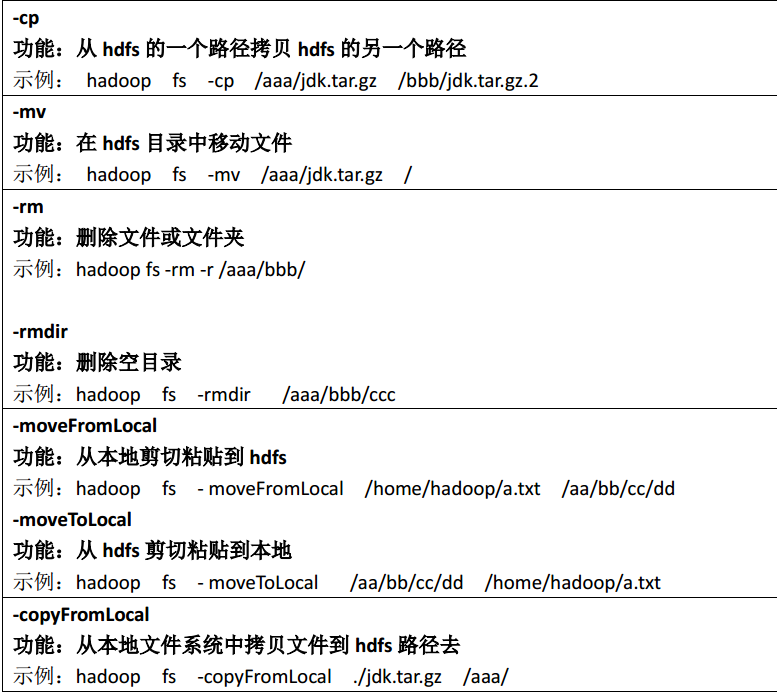
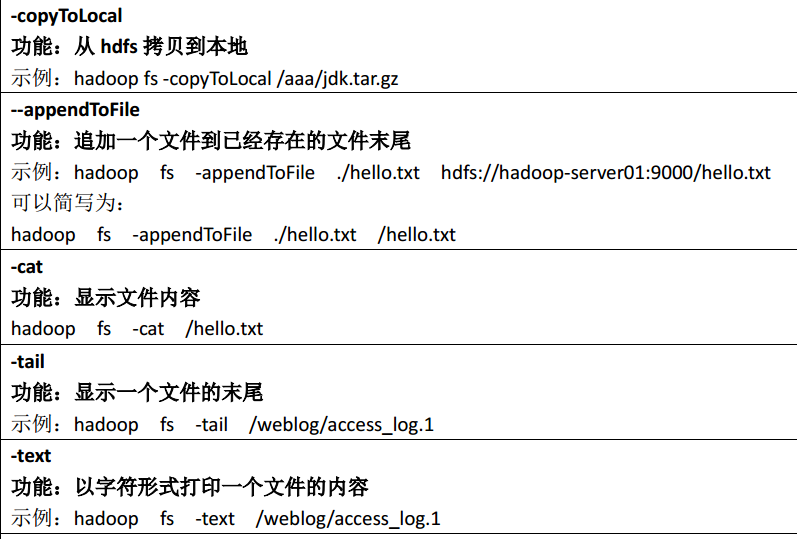
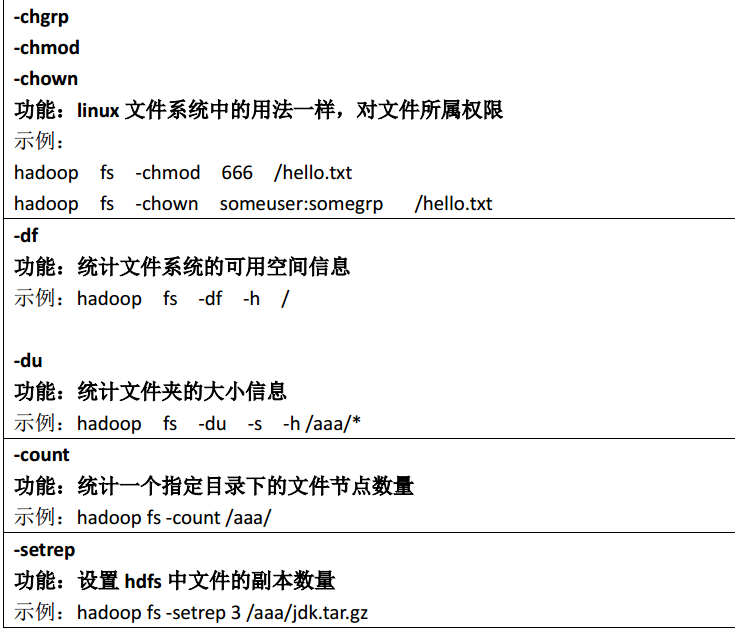
五、HDFS的Java API操作
1、利用eclipse 查看HDFS集群的文件信息
(1)下载一个 eclipse 开发工具 eclipse-jee-luna-SR1-win32-x86_64.zip
(2) 解压到一个文件夹 C:\myProgram\eclipse
(3) 把 hadoop-eclipse-plugin-2.6.4.jar 放入到 eclipse/plugins 文件夹下
(4)双击启动 eclipse
(5) 将 无 jar 版 windows 平台 hadoop-2.6.1.zip 解压到 windows 系统下一个文件夹下,文件 夹的路径最好不要带中文。我的目录是: C:\myProgram\hadoop-2.6.1
(6) 打开了 eclipse 之后, 点击 windows –> prefrences -> 会出现一个对话框。找到如图所示 Hadoop MapReduce 选项: 然后把你安装的 hadoop 路径配置上,就是上一步你解压的那 个文件夹: C:\myProgram\hadoop-2.6.1,然后保存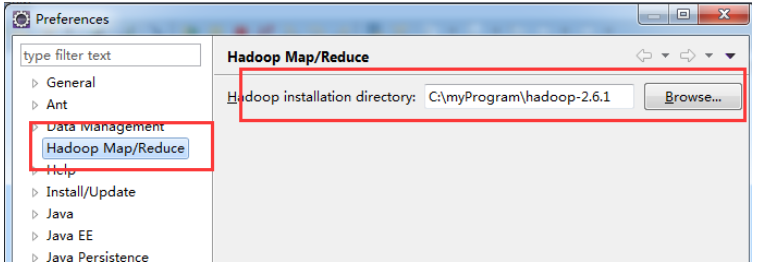
(注意的是如果 C:\myProgram\hadoop-2.6.1下还有一层文件就是hadoop-2.6.1,要写到C:\myProgram\hadoop-2.6.1\hadoop-2.6.1)
(7) 然后点击 windows show view other 在列表中找到图中这个东西: 然后双击

(8)然后会出现这么一个显示框

(9)咱们点击红框中这个东西,会出现相应的这么一个对话框,修改相应的信息,

(10)填完以上信息之后,点击 finish 会出现:

(11)最重要的时候在左上角的这个地方会出现:
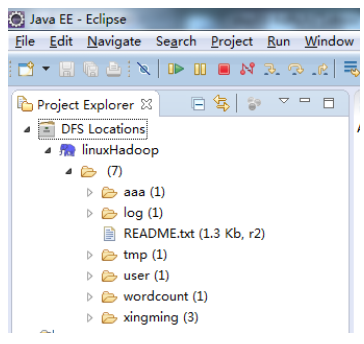
至此,我们便完成了,利用 hadoop 的 eclipse 插件链接 hdfs 集群实现查看 hdfs 集群文件的 功能,大功告成。
2、搭建开发环境
创建Java project ,导入操作HDFS的jar包,导入的jar包有:
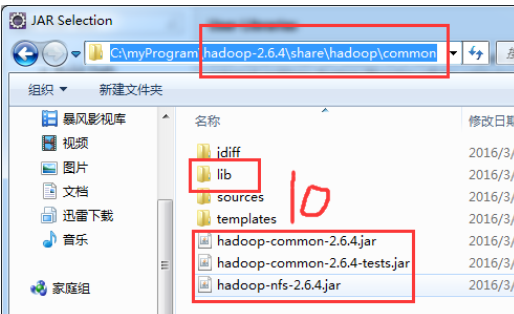

3、FileSystem实例获取讲解
在 java 中操作 hdfs,首先要获得一个客户端实例:
Configuration conf = new Configuration()
FileSystem fs = FileSystem.get(conf)
而我们的操作目标是 HDFS,所以获取到的 fs 对象应该是 DistributedFileSystem 的实例; get 方法是从何处判断具体实例化那种客户端类呢?
——从 conf 中的一个参数 fs.defaultFS 的配置值判断;
如果我们的代码中没有指定 fs.defaultFS,并且工程 classpath 下也没有给定相应的配置, conf 中的默认值就来自于 hadoop 的 jar 包中的 core-default.xml,默认值为: file:///,则获取的 将不是一个 DistributedFileSystem 的实例,而是一个本地文件系统的客户端对象
4、HDFS常用Java API演示
|
1
2
3
4
5
6
7
8
9
10
11
12
13
14
15
16
17
18
19
20
21
22
23
24
25
26
27
28
29
30
31
32
33
34
35
36
37
38
39
40
41
42
43
44
45
46
47
48
49
50
51
52
53
54
55
56
57
58
59
60
61
62
63
64
65
66
67
68
69
70
71
72
73
74
75
76
77
78
79
80
81
82
83
84
85
86
87
88
89
90
91
92
93
94
95
96
97
98
99
100
101
102
103
104
105
106
107
108
109
110
111
112
113
114
115
116
117
118
119
120
121
122
123
124
125
126
127
128
129
130
131
132
133
134
135
136
137
138
139
140
141
142
143
144
145
146
147
148
149
150
151
152
153
154
|
package
com.ghgj.hdfs;
import
java.io.IOException;
import
org.apache.hadoop.conf.Configuration;
import
org.apache.hadoop.fs.BlockLocation;
import
org.apache.hadoop.fs.FileStatus;
import
org.apache.hadoop.fs.FileSystem;
import
org.apache.hadoop.fs.LocatedFileStatus;
import
org.apache.hadoop.fs.Path;
import
org.apache.hadoop.fs.RemoteIterator;
public
class
HDFSDemo {
static
FileSystem fs =
null
;
static
Configuration conf =
null
;
public
static
void
main(String[] args)
throws
Exception {
init();
// testMkdirs();
// testPut();
// testGet();
// testConf();
// testDelete();
// testRename();
// testList();
close();
}
public
static
void
testConf(){
/**
* 给我们要操作的hdfs集群设置配置信息的方式有三种:
* 第一种:通过代码,用conf.set()
* 第二种:直接接在jar里面所携带的默认的core-default.xml
* 第三种:加载我们项目自带的关于集群配置相关的xml
*/
/**
* 1 > 3 > 2 加载级别高低,也就是谁后生效
* 加载顺序:默认配置 , 集群安装配置=项目配置文件, 代码里面设置的配置信息
*/
String fileSystem = conf.get(
"fs.defaultFS"
);
String string = conf.get(
"dfs.replication"
);
System.out.println(fileSystem);
System.out.println(string);
// conf.addResource(new Path("./myxmltext.xml"));
// conf.addResource("myxmltext.xml");
// System.out.println(conf.get("myname"));
}
/**
* 初始化fs链接
* @throws IOException
*/
public
static
void
init()
throws
IOException{
conf =
new
Configuration();
conf.set(
"fs.defaultFS"
,
"hdfs://hadoop02:9000"
);
System.setProperty(
"HADOOP_USER_NAME"
,
"hadoop"
);
fs = FileSystem.get(conf);
}
/**
* 关闭fs链接
* @throws IOException
*/
public
static
void
close()
throws
IOException{
fs.close();
}
/**
* 删除文件夹或者文件
* @throws IOException
*/
public
static
void
testDelete()
throws
IOException{
fs.delete(
new
Path(
"/abcd"
),
true
);
}
/**
* 重命名
* @throws IOException
*/
public
static
void
testRename()
throws
IOException{
fs.rename(
new
Path(
"/txt1.txt"
),
new
Path(
"/huangbo.txt"
));
}
/**
* 遍历文件
* @throws IOException
*/
public
static
void
testList()
throws
IOException{
// 遍历某个路径下所有的文件节点。包括文件和文件夹
/*FileStatus[] listStatus = fs.listStatus(new Path("/"));
for(FileStatus fss: listStatus){
boolean directory = fss.isDirectory();
if(directory){
System.out.println(fss.getPath()+" -- 文件夹");
}else{
System.out.println(fss.getPath()+" -- 文件");
}
}*/
// 只遍历文件
RemoteIterator<LocatedFileStatus> listFiles = fs.listFiles(
new
Path(
"/"
),
true
);
while
(listFiles.hasNext()){
LocatedFileStatus next = listFiles.next();
boolean
directory = next.isDirectory();
// next.getBlockSize()
BlockLocation[] blockLocations = next.getBlockLocations();
for
(BlockLocation bl: blockLocations){
String[] hosts = bl.getHosts();
System.out.println(
"长度:"
+bl.getLength());
for
(String s: hosts){
System.out.print(s +
"\t"
);
}
System.out.println(next.getPath());
}
/*if(directory){
System.out.println(next.getPath()+" -- 文件夹"+ blockLocations.length);
}else{
System.out.println(next.getPath()+" -- 文件"+ blockLocations.length);
}*/
}
}
/**
* s上传文件
* @throws IOException
*/
public
static
void
testMkdirs()
throws
IOException{
boolean
mkdirs = fs.mkdirs(
new
Path(
"/abcd/nnn/mmm/uuu/jjj"
));
System.out.println(mkdirs);
}
/**
* 上传文件
* @throws IOException
*/
public
static
void
testPut()
throws
IOException{
fs.copyFromLocalFile(
new
Path(
"C:/wdata/student.txt"
),
new
Path(
"/abcd"
));
}
/**
* 下载文件
* @throws IOException
*/
public
static
void
testGet()
throws
IOException{
fs.copyToLocalFile(
new
Path(
"/abcd/student.txt"
),
new
Path(
"C:/ss.txt"
));
System.out.println(
"is done"
);
}
}
|
5、HDFS流式数据访问
相对那些封装好的方法而言的更底层一些的操作方式 上层那些 mapreduce spark 等运算 框架,去 hdfs 中获取数据的时候,就是调的这种底层的 api
|
1
2
3
4
5
6
7
8
9
10
11
12
13
14
15
16
17
18
19
20
21
22
23
24
25
26
27
28
29
30
31
32
33
34
35
36
37
38
39
40
41
42
43
44
45
46
47
48
49
50
51
52
53
54
55
56
57
58
59
60
61
62
63
64
65
66
67
68
69
70
71
72
73
74
75
76
77
78
79
|
package
com.ghgj.hdfs;
import
java.io.File;
import
java.io.FileInputStream;
import
java.io.FileOutputStream;
import
org.apache.hadoop.conf.Configuration;
import
org.apache.hadoop.fs.FSDataInputStream;
import
org.apache.hadoop.fs.FSDataOutputStream;
import
org.apache.hadoop.fs.FileSystem;
import
org.apache.hadoop.fs.Path;
import
org.apache.hadoop.io.IOUtils;
public
class
TestHDFSStream {
static
Configuration conf =
null
;
static
FileSystem fs =
null
;
public
static
void
main(String[] args)
throws
Exception {
init();
// getHDFSFileByStream();
putFileToHDFS();
close();
}
/**
* 通过流的方式,去HDFS上下载一个文件下来
* 实现思路:
* 1、利用一个输入流读取该文件的数据
* FSI = fs.open(path);
* 2、......
* 3、获取文件输出流,把输入流的数据给存到本地
*/
public
static
void
getHDFSFileByStream()
throws
Exception{
// 获取数据输入流
Path path =
new
Path(
"hdfs://hadoop02:9000/hadoop-2.6.4-centos-6.5.tar.gz"
);
FSDataInputStream open = fs.open(path);
// 获取文件输出流
FileOutputStream fos =
new
FileOutputStream(
new
File(
"c:/myhadoop.txt"
));
// 作用:让输入流和输出流对接,进行数据的传输(复制)
// IOUtils.copyBytes(open, fos, conf);
IOUtils.copyBytes(open, fos, conf.getInt(
"io.file.buffer.size"
,
4096
),
true
);
}
/**
* 实现思路:
* 1、获取一个本地文件的输入流
* 2、、、
* 3、在hdfs的客户端创建一个输出流,把输入流上的数据复制到hdfs文件系统里面去
*/
public
static
void
putFileToHDFS()
throws
Exception{
// 获取一个本地文件的输入流
FileInputStream fin =
new
FileInputStream(
new
File(
"c:/myhadoop.txt"
));
// 准备一个hdfs的输出流
Path path =
new
Path(
"/myhadoop.tar.gz"
);
FSDataOutputStream create = fs.create(path);
IOUtils.copyBytes(fin, create, conf);
}
public
static
void
init()
throws
Exception{
conf =
new
Configuration();
conf.set(
"fs.defaultFS"
,
"hdfs://hadoop02:9000"
);
System.setProperty(
"HADOOP_USER_NAME"
,
"hadoop"
);
fs = FileSystem.get(conf);
}
public
static
void
close()
throws
Exception{
fs.close();
}
}
|
经典案例:
在 mapreduce 、 spark 等运算框架中,有一个核心思想就是将运算移往数据,或者说,就是 要在并发计算中尽可能让运算本地化,这就需要获取数据所在位置的信息并进行相应范围读 取。 以下模拟实现:获取一个文件的所有 block 位置信息,然后读取指定 block 中的内容
|
1
2
3
4
5
6
7
8
9
10
11
12
13
14
15
16
17
18
19
20
21
22
23
24
25
26
27
28
29
|
@Test
public
void
testCat()
throws
IllegalArgumentException, IOException {
FSDataInputStream in = fs.open(
new
Path(
"/weblog/input/access.log.10"
));
// 拿到文件信息
FileStatus[] listStatus = fs.listStatus(
new
Path(
"/weblog/input/access.log.10"
));
// 获取这个文件的所有 block 的信息
BlockLocation[] fileBlockLocations = fs.getFileBlockLocations(
listStatus[
0
], 0L, listStatus[
0
].getLen());
// 第一个 block 的长度
long
length = fileBlockLocations[
0
].getLength();
// 第一个 block 的起始偏移量
long
offset = fileBlockLocations[
0
].getOffset();
System.out.println(length);
System.out.println(offset);
// 获取第一个 block 写入输出流
// IOUtils.copyBytes(in, System.out, (int)length);
byte
[] b =
new
byte
[
4096
];
FileOutputStream os =
new
FileOutputStream(
new
File(
"d:/block0"
));
while
(in.read(offset, b,
0
,
4096
) != -
1
) {
os.write(b);
offset +=
4096
;
if
(offset > length)
return
;
}
os.flush();
os.close();
in.close();
}
|
案例:
|
1
2
3
4
5
6
7
8
9
10
11
12
13
14
15
16
17
18
19
20
21
22
23
24
25
26
27
28
29
30
31
32
33
34
35
36
37
38
39
40
41
42
43
44
45
46
47
48
49
50
51
52
53
54
55
56
57
58
59
60
61
62
63
64
65
66
67
68
69
70
71
72
73
74
75
76
77
78
79
80
81
82
83
84
85
86
|
package
com.ghgj.hdfs;
import
java.io.File;
import
java.io.FileOutputStream;
import
java.net.URI;
import
org.apache.hadoop.conf.Configuration;
import
org.apache.hadoop.fs.BlockLocation;
import
org.apache.hadoop.fs.FSDataInputStream;
import
org.apache.hadoop.fs.FileStatus;
import
org.apache.hadoop.fs.FileSystem;
import
org.apache.hadoop.fs.Path;
import
org.apache.hadoop.io.IOUtils;
public
class
TestRandomStream {
public
static
void
main(String[] args)
throws
Exception {
// testSeek();
getSecondBlock();
}
/**
* 通过HDFS api 取到对应数据对应数据块的数据
* 作用:
* @throws Exception
*/
public
static
void
getSecondBlock()
throws
Exception{
Configuration conf =
new
Configuration();
FileSystem fs = FileSystem.get(
new
URI(
"hdfs://hadoop02:9000"
), conf,
"hadoop"
);
FSDataInputStream open = fs.open(
new
Path(
"/hadoop-2.6.4-centos-6.5.tar.gz"
));
// 134217728
// 46595337
long
offset =
0
;
long
length =
0
;
FileStatus[] listStatus = fs.listStatus(
new
Path(
"/hadoop-2.6.4-centos-6.5.tar.gz"
));
length = listStatus[
0
].getLen();
BlockLocation[] fileBlockLocations = fs.getFileBlockLocations(listStatus[
0
],
0
, length);
// 想要获取到hadoop安装包第二块数据的数据块的起始偏移量
offset = fileBlockLocations[
1
].getOffset();
// 设置起始偏移量
open.seek(offset);
long
seekLength = fileBlockLocations[
1
].getLength();
System.out.println(offset+
"\t"
+seekLength);
// 构建文件输出流
FileOutputStream fout =
new
FileOutputStream(
new
File(
"c:/secondHadoop.tar.gz"
));
// 把输入流数据,复制到输出流
IOUtils.copyBytes(open, fout, seekLength,
true
);
fs.close();
}
/**
* 从随机位置offset读取任意长度length的数据
* @throws Exception
*/
public
static
void
testSeek()
throws
Exception{
Configuration conf =
new
Configuration();
// System.setProperty("HADOOP_USER_NAME", "hadoop");
FileSystem fs = FileSystem.get(
new
URI(
"hdfs://hadoop02:9000"
), conf,
"hadoop"
);
FSDataInputStream open = fs.open(
new
Path(
"hdfs://hadoop02:9000/shuzi.txt"
));
long
offset =
12
;
long
length = 23L;
// 设置起始偏移量
open.seek(offset);
FileOutputStream fout =
new
FileOutputStream(
new
File(
"c:/myshuzi.txt"
));
// 注意第三个参数:它是long类型。表示取数据的长度
IOUtils.copyBytes(open, fout, length,
true
);
fs.close();
}
}
|





















 668
668











 被折叠的 条评论
为什么被折叠?
被折叠的 条评论
为什么被折叠?








